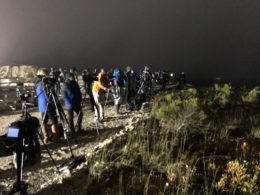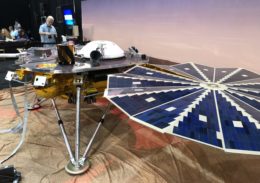
JPL’s Stephanie Smith introduces the InSight prelaunch press briefing next to a model of the Atlas-V rocket. [AAS Nova]
A Unique Journey
Today’s launch marked the first interplanetary launch to take off from the west coast. Usually, launches to other planets occur from the east coast; this is because the Earth’s spin gives the rocket an extra boost when it launches east.
But rocket launchpads are crowded, and the wait to get in on the east coast can be extremely inconvenient for an interplanetary mission with a specific timeline for when it needs to launch. InSight had an alternative, however: the Atlas-V rocket was still plenty powerful — even with the southward launch from Vandenberg — to hoist InSight and send it on its way into a parking orbit. After launch, the second stage then boosted InSight out of Earth’s orbit and on its way to Mars.
What Happens Next?
205 days from now, in November of this year, InSight will arrive at Mars and proceed to enter the planet’s atmosphere at more than 13,000 mph. A parachute will then slow it to around ~130 mph before the lander separates and lowers itself to Mars’s surface using 12 descent engines.So once InSight touches down, it can start doing science, right? Not so fast! The placement of the lander’s instruments on the ground will take 10 weeks after it lands; sinking the heat probe will then take another 7 weeks after that. Impatient? Do try to remember that we’re operating a robot on Mars.
Experiencing InSight’s Launch Firsthand
I had the good fortune of being able to catch the InSight launch in person today, as well as the lead-up to it. At Thursday’s press briefing, the media gathered at the NASA building on Vandenberg AFB to hear from people representing multiple facets of the mission — from those who built it, to those who would be launching it, to those who will manage the science that comes from it.

Reporters ready to photograph the InSight launch to Mars, should Vandenberg’s marine layer clear out in time for a view. [AAS Nova]
Fortunately, you wouldn’t have known it from the launch itself! Liftoff occurred right on schedule at the start of the first launch window, and the Atlas-V took off without a hitch. For those of us in the press viewing area at Vandenberg, a typical blanket of marine-layer fog enveloped us, hiding the launch from view. But the roar of the engines and tremble of the ground is unmistakable, and we could hear cheers echoing in the distance around us through the fog, alerting us to the success of the first step in InSight’s journey to Mars. Sometimes, being awake at 4 am can be pretty awesome.


1 Comment
Pingback: Allgemeines Live-Blog vom 30. 4. bis 6. 5. 2018 | Skyweek Zwei Punkt Null